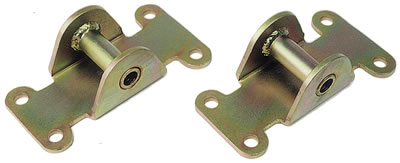Engine Mounts 101: A Basic Guide to Choosing Engine Mounts
It’s a dirty, thankless job, but someone (or something) has to do it.
Deep down in the abyss of your engine bay, engine mounts are tasked with the tough job of holding your engine in place. They typically attach your engine to three or four points on your vehicle’s frame or subframe. An engine mount’s job description also includes absorbing engine noise and vibration and preventing misalignment between driveline components under high loads.
As you can see, motor mounts perform some very important tasks, yet they rarely get any attention for their work.
Until they fail.
Signs of a bad engine mount often include more noticeable vibration inside the vehicle, increased engine noise, or excessive engine movement. All motor mounts are designed to allow some flex or movement, but too much engine movement can lead to strain on your driveline and even prevent normal clutch and transmission operation.
If you look at any forum discussion on motor mounts, you’ll notice that opinions vary widely on what makes the best engine mount materials. That’s because the right choice can come down to your personal feelings about how much vibration is too much…or how much power loss at the wheels is too much. Quite simply, there is a give and take between engine mount materials, and choosing the right mount often comes down to your intended vehicle use.
Rubber engine mounts, like the ones provided by the factory, offer the greatest vibration and noise dampening effect. However, there are a few drawbacks to the old rubber-style mounts. They can be prone to cracking and tearing after a while, and also allow the most movement under load. This means less power is transferred from the engine through the driveline and into the rear wheels. Rubber mounts are ideal for stock or mildly modified street engines, but as horsepower is increased, it may be time to upgrade.
Companies like Energy Suspension and Prothane offer polyurethane engine mounts that provide a compromise between rubber and rigid solid mounts. The harder properties of the polyurethane hold the engine in place better than spongier rubber. This allows more energy to be transferred back through the driveline.
But here’s where it gets tricky.
Polyurethane will allow more vibration than rubber mounts because of its increased stiffness. Depending on your vehicle, horsepower, and engine mount brand, the amount of vibration can vary. Your experience may differ from that of another person because of differences in the hardness and flexibility of the polyurethane. In general, though, polyurethane is tougher and more rigid than rubber, making it ideal for more highly modified vehicles.
“We often recommend poly when there are increases in horsepower,” said Summit Racing Tech Advisor Carl Pritts. “Energy Suspension or Prothane mounts have limiting straps built in so they can’t be torn or stretched apart.”
Pritts also offered this compromise:
“What if I like the dampening effect the rubber mounts give me, but I also need a stronger mount like the poly? How about using a torque-limiting strap, such as the one offered by Competition Engineering, in conjunction with new rubber mounts. You get the best of both worlds, although some modifications may be required.”
On the opposite end of the scale from rubber mounts, are solid engine mounts. There’s no rubber or polyurethane involved, so these all-metal mounts are the least forgiving. Because they create a metal-on-metal connection, they permit the most vibration and noise. However, they also transfer the most amount of power to the wheels because they flex very little under load. Pritts says solid mounts should be used only for competition because of the vibration and noise factors.
“These are best for the highest horsepower, race-only applications,” Pritts said. “Summit Racing does not ever recommend them for street usage.”
Pritts says Summit Racing does not recommend mixing and matching motor mounts either.
“If solid mounts will be used, they should be used in all locations,” he said. “If one mount is flexible and the others are not, this flex point may cause broken parts such as a bellhousing. Again, we recommend solid mounts for race apps only!”
Whether you’re replacing worn mounts, choosing engine mounts for a brand new engine, or looking for special engine swap motor mounts, you’ll find a dizzying array of choices. Be honest with yourself about your vehicle’s intended use, future modifications, and the importance of a comfortable ride.








I have a high horsepower street car and I run solid mounts on engine and a polyeuratnane on the trans. Works for me , no problem
I use that same setup, works for me too.
On my 440 4 speed GTX I finally went to the rubber mounts that have the inner locking mechanism in them with no failures ever. Its the best of both worlds.
I am installing 2, 385 series Ford engines in my 1964 P350 Van. I used the original mount locations along with modified PROTHANE material. The joining fixture btwn the engines is self designed, built and machined. Alignment of this assembly was accomplished with pressure sensative material and s/s shims btwn mounts and frame.